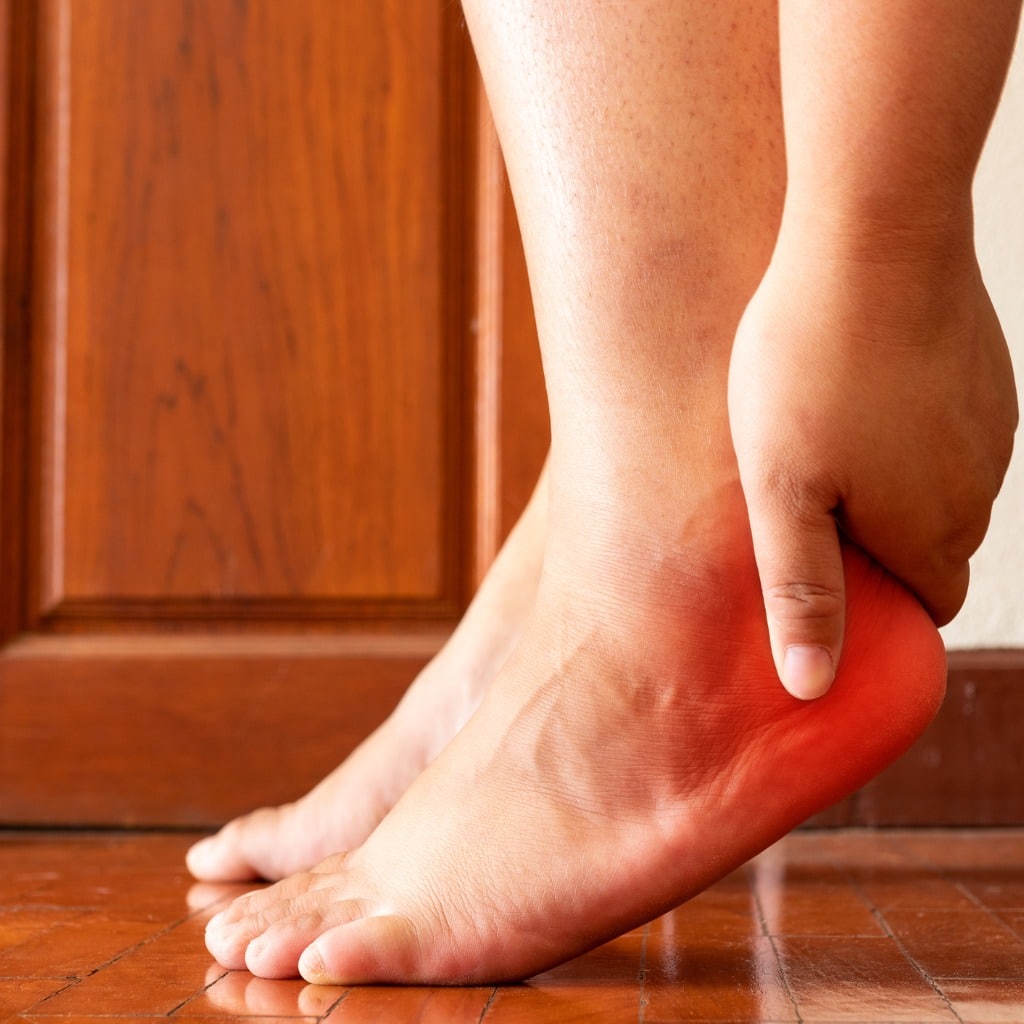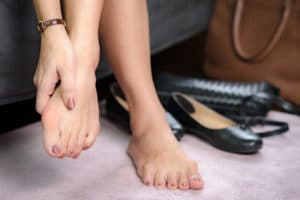Heel pain is a common problem for runners, people with naturally tight calf muscles, and those with high arches. It’s usually assumed the person has a heel spur, a bony growth on the underside of the heel. But in most cases, this isn’t the actual source of pain, and the person may have “heel spur syndrome” instead.
At Precision Foot and Ankle, our expert doctors help patients get past their chronic heel pain with conservative treatments and occasionally surgery. Click here to visit our contact page and find the number of an office near you, or to fill out and submit an appointment request form to our experienced doctors!

What is a Heel Spur?
A heel spur is a calcium deposit causing a bony protrusion on the bottom of the heel bone. Heel spurs can extend forward as much as half an inch, and they will show up on an x-ray.
What Causes Heel Pain?
Although people with heel pain believe a heel spur has developed on the bottom of their foot and that is causing their pain, the reality says otherwise. Heel spurs are common, but they only cause pain in about 5 percent of people who have a visible heel spur on an x-ray.
More often, the pain is associated with plantar fasciitis, a painful inflammation of the fibrous band of connective tissue (plantar fascia) that runs along the bottom of the foot and connects the heel bone to the ball of the foot.
What Causes a Heel Spur to Form?
Heel spurs form when calcium deposits build up on the underside of the heel bone. This usually takes a period of months to happen. Heel spurs are often caused by strains on foot muscles and ligaments, stretching of the plantar fascia, and repeated tearing of the membrane that covers the heel bone. Heel spurs are common in athletes whose sport involves lots of running and jumping.
Who is at Risk for Developing Heel Spurs?
These factors increase the odds a person will develop a heel spur:
- Walking gait abnormalities, where the person places excessive stress on the heel bone, ligaments, and nerves near the heel
- Running or jogging, especially on hard surfaces
- Poorly fitting or overly worn shoes, especially those lacking arch support
- Excess weight/obesity
These risk factors are associated with plantar fasciitis, which can be causing heel pain:
- Increasing age, as the plantar fascia loses flexibility, thinning the protective fat pad in the heel
- Diabetes
- Spending most of the day on one’s feet
- Frequent short bursts of physical activity
- Having either flat feet or high arches
What People Say
Symptoms of a Heel Spur
 Heel spurs often don’t cause any pain or symptoms, but they can be associated with intermittent or chronic pain, especially when walking, jogging, or running. This will occur if there is inflammation at the point of the spur formation.
Heel spurs often don’t cause any pain or symptoms, but they can be associated with intermittent or chronic pain, especially when walking, jogging, or running. This will occur if there is inflammation at the point of the spur formation.
This pain can be described as like a knife or pin sticking to the bottom of the person’s foot when they first stand up in the morning. As the ligaments and tissues stretch the pain can turn into a dull ache. But if the person sits for a prolonged period, the sharp pain will return when he or she stands up.
How is a Heel Spur Treated?
With most heel pain, the spur isn’t the actual problem. Unlike many causes of inflammation, rest won’t help with the pain of heel spurs and plantar fasciitis. That’s because after rest, when you arise you stretch and pull on the heel, elongating the plantar fascia, causing pain.
At Precision Foot and Ankle, we usually advise patients to come to see us if they have had heel pain for more than one month. We will work through conservative treatments first. These may include:
- A stretching exercise regimen
- Changing to different shoes
- Taping or strapping to rest the stressed muscles and tendons
- Shoe inserts or orthotics
- Physical therapy
- Night splints
- Anti-inflammatory medications (Tylenol, Advil, or Aleve)
- Corticosteroid injections
Is Surgery Necessary to Address Heel Spurs?
In over 90 percent of the patients, the conservative treatments listed above solve the patient’s problem and they can get past the pain. But if conservative options have not stopped the pain after a period of 9-12 months, surgery could be the next option.
Since the heel spur itself is not usually the cause of the pain, it is not removed in most cases. Instead, our board-certified foot surgeons perform a plantar fasciotomy. This is usually done using minimally invasive methods employing an endoscope. In the simple procedure, a small surgical hook is inserted and used to cut a portion of the fascia. The procedure takes just 15-20 minutes. The purpose of a plantar fasciotomy is to release a tight or contracted plantar fascia. The cut portion lengthens roughly one inch and heals in this lengthened position during recovery.
Is Recovery after a Plantar Fasciotomy Painful?
The first portion of recovery requires two weeks of non-weight bearing on the operative foot. This can involve crutches, a walker, a rolling knee scooter, or a wheelchair. After those two weeks, patients can progressively add pressure to the foot while wearing a walking boot for four weeks. At six weeks, most patients can transition to a supportive tennis shoe. It’s about 10 weeks before the patient can return to recreational physical activity.
Are the Results from a Plantar Fasciotomy Permanent?
These procedures have a success rate of over 90 percent. The results are permanent, but sometimes a second release could be necessary to achieve full relief.
Can Heel Spurs Go Away on their Own?
If you upgrade your shoes, maybe stop running and switch to cycling, stretch, and take anti-inflammatory medications, your heel spur pain could go run its course. The heel spur itself won’t go away, as it is calcified bone, but it’s not usually the cause of your pain anyway. However, if you keep the same routine and don’t upgrade your shoes or activities, your heel spur pain will continue. It won’t magically one day vanish.
Can I Prevent Heel Spurs?
You can prevent a heel spur from ever getting started. Wear well-fitting shoes with shock-absorbent soles, rigid shanks, and supportive heel counters. Choose shoes appropriate to the activity. Warm-up and stretch before any activity, and try not to go from zero to 60, figuratively. When your shoes start to wear on the heels, don’t skimp, get a new pair. Finally, being overweight increases your risks for developing a heel spur, so maintaining a healthy weight helps with prevention.
Schedule Your Consultation Today
If you're interested in learning more about heel spurs please contact us for a consultation. We will discuss your needs and concerns, and determine your best course of action.
